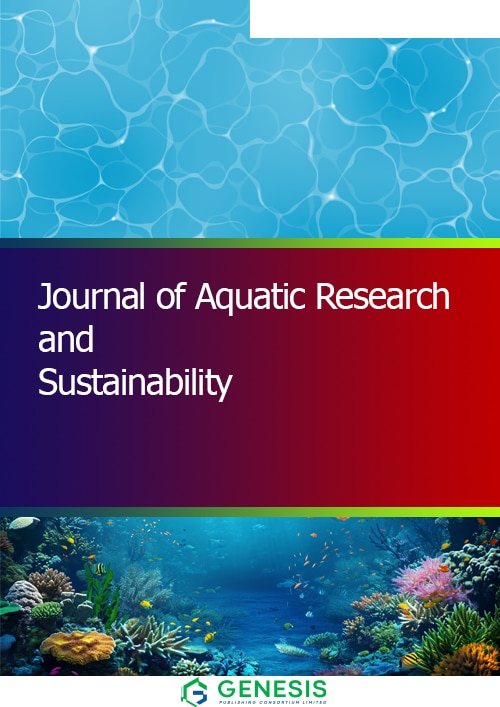Aquaculture production has bloomed steadily in recent years and is the fastest-growing food production sector in the world (Verdegem et al., 2023). Unfortunately, the global growth of aquaculture has resulted in negative environmental impacts (Chávez-Crooker and Obreque-Contreras, 2010). Increased uneaten feed and nitrogenous waste product excreted by cultured animals will elevate the ammonia concentration in aquaculture system. This can lead to eutrophication in the water bodies and a decline in aquatic life health (Kim et al., 2016). In aquaculture ponds, nitrogen typically exists as dissolved inorganic nitrogen in the form of unionized ammonia (NH3), ammonium ion (NH4+), nitrite (NO2-) and nitrate (NO3-) or as dissolved organic nitrogen mostly as urea, protein and amino acids (Ross et al., 2018). In aquaculture, ammonia is the most common nitrogenous waste as it is the principle product of protein metabolism in aquatic organisms (Chen and Wang, 2020).
In recent years, microalgae have been widely used in treating wastewater due to their ability to use inorganic and organic nitrogen. Microalgae is a single-celled photosynthetic organisms, use light energy, inorganic nutrients, and carbon dioxide to create biomass. This biomass has various practical uses, including biofuel production, aquaculture feed, and applications in the cosmetics industry (Ansari et al., 2017). Microalgae require a substantial quantity of nitrogen and phosphorus to thrive since nitrogen is the building block for protein, nucleic acids and phosphorus as a component of phospholipids (Gatamaneni et al., 2018). Microalgae can utilize various nitrogen forms, including nitrate, nitrite, ammonium, and organic nitrogen like urea and amino acids (Salbitani and Carfagna, 2021). The nitrogen source will influence growth rates, microalgal biomass production and nutrient uptake by the microalgae (Ross et al., 2018).
In addition, the application of indigenous microalgae species for bioremediation of nutrients has been proven to be efficient as the indigenous microalgae species had a shorter acclimatization time, higher removal efficiencies of nutrients as well as better species dominance in the system (AlMomani and Örmeci, 2016). In order to apply certain microalgae species for nitrogen removal in aquaculture water, understanding the growth and nitrogen uptake by the microalgae is essential. Accordingly, in this study, Malaysian indigenous microalgal species were isolated, identified and screened for the ability to remove ammonia. The best species was further investigated to assess its growth and nitrogen removal performance under varying ammonia and nitrogen concentrations. Additionally, the study evaluated the nitrogen bioremediation efficiency of the selected microalgal species in treating shrimp aquaculture wastewater.
2. Materials and Methods
2.1 Ethical approval
No ethical approval is required for this study.
2.2 Sampling and isolation of indigenous microalgae
Water samples were collected from two whiteleg shrimp Penaeus vannamei ponds which were in Manjung BioOcean in Selangor, West Coast of Malaysia (3°33’N, 101°23’E) and i-SHARP Blue Archipelago in Terengganu, East Coast of Malaysia (5°55’N, 102°89’E) (Figure 1). Samples were collected from both the surface and middle layers of the water at each site, aiming to identify the dominant microalgal species in those specific areas. Microalgae were sampled using a 20 µm plankton net and all field samples were placed in 500 mL polyethylene bottles maintained at 4 °C before laboratory transfer. For microalgae isolation, the cells were subjected to purification by serial dilution followed by plating. Multiple media recipes such as Guillard’s F/2 medium with silica (Guillard and Ryther, 1962) and Kosaric medium (Mia et al., 2018) were utilized to isolate the colonies. The individual colonies were microscopically observed for their colonial and morphological features. Pure culture was obtained from a single colony and established in liquid culture of respective media, incubated at 25 °C under 80 µmol photons m-2 s-1 light at 25 °C with 12:12 h light and dark cycles. The culture's purity was maintained through multiple plating cycles and regular microscopic examinations for quality control.

2.3 Identification of indigenous microalgae
The genomic DNA of isolated microalgae was extracted using GeneaidTM DNA Isolation kit (Geneaid Biotech Ltd, Taiwan). The 18S rRNA fragments of green microalgae and diatom were amplified using P45F and P47R (Dorigo et al., 2002) while 16S rRNA of cyanobacteria were amplified using CYA359F and CYA781R (Lymperopoulou et al., 2011). PCR amplification was performed following GoTaq® DNA Polymerase protocol (Promega, USA). The reaction condition was as follows: initial denaturation at 95 ºC for 2 min, 30 amplification cycles of denaturation at 95 ºC for 30 s, annealing at 57 ºC for 30 s and extension 72 ºC for 1 min, followed by final extension 72 ºC for 5 min. The amplified DNA fragments were examined by electrophoresis on a Tris Borate EDTA (TBE) 1.5 % agarose gel (100V). The PCR products were purified and sequenced by the First Base Laboratories Sdn. Bhd. Following the cleaning up and editing using BioEdit 7.2.5 software, 18S and 16S rRNA nucleotide sequences were compared with the sequences data in the National Center of Biotechnology Information (NCBI) using the BLAST program. Finally, the obtained DNA sequences with the most closely related species were preliminarily aligned with ClustalW Multiple Alignment software and the phylogenetic analyses were performed using MEGA 7 (Kumar et al., 2016). The maximum-likelihood approach was used to generate the phylogenetic tree. The resultant tree topology was evaluated by bootstrap analyses based on 1000 replicates.
2.4 Screening of microalgae for ammonia removal in media with supplemented ammonia
Five microalgal species that were successfully purified from the pond water samples were subjected to screening for ammonia removal in a modified F/2 media with silica- containing 2 mg L-1 Total Ammonia Nitrogen (TAN). A treatment consisting of only medium added with 2 mg L-1 TAN and without inoculation of microalga was used as a control treatment. TAN was referred to as ammonia throughout the text. The ammonia was generated using ammonium sulphate stock solution (9.343 g (NH4)2SO4) in 1 L of ultrapure water; 1 mL = 1 mg N).
An initial inoculum concentration of 0.1 g L-1 dry weight of respective microalga species was inoculated in the Erlenmeyer flask, containing the respective medium. The experiments were conducted under 80 µmol m -2 s-1 light at 25 °C and pH of 8.0 under 12:12 h light and dark cycles. Water samples were collected daily to determine TAN removal and the microalgae growth in microalgae biomass (g DW L-1). The experiment was conducted in 14 days.
2.5 Effect of various nitrogen sources concentration on nitrogen uptake and biomass productivity of Halamphora sp.
In the second experiment, Halamphora sp., which had the fastest ammonia removal efficiency in the previous experiment was selected for further investigation on the effect of various concentrations of ammonia and nitrate on their growth and bioremediation potential. An aliquot of exponentially-growing Halamphora sp. was harvested by centrifugation at 3000 rpm for 15 minutes. The cells were washed twice and resuspended in sterile seawater to remove any remaining nutrients from the culture media. Initial inoculum of 1 × 104 cells/mL of Halamphora sp. was inoculated in each 1000 mL Erlenmeyer flask containing 500 mL F/2 medium with different nitrogen concentrations.
The treatments were applied as follows, i) ammonia (4, 8, 12, 16, 20 and 25 mg L-1 TAN) and ii) nitrate (4, 8, 12, 16, 20 and 25 mg L-1 NO3--N), respectively. The NO3--N was prepared using sodium nitrate 1000 mg L-1 stock solution (1.371 g NaNO3 in 1 L of distilled water) while ammonia (TAN) was prepared using an ammonium sulphate 1000 mg L-1 stock solution (9.343 g (NH4)2SO4 in 1 L of distilled water). A concentration of 12 mg L-1 of NO3—N without inoculation of Halamphora sp. was used as a control. The experiment was carried out in triplicates for 14 days. The experiment was conducted in triplicates under cool white fluorescent tube light (80 µmol m-2 s-1) with 12:12 h light and dark cycles at 25 °C. The experiment was carried out in triplicates and lasted for 14 days.
2.6 Bioremediation of shrimp culture wastewater by Halamphora sp.
Shrimp culture wastewater was obtained from Penaeus vannamei farming ponds in Setiu, Terengganu, Malaysia. The wastewater was taken from different stages; the early stage of farming (7 days of culture) and the end stage (85 days of culture), right before the shrimp were harvested. Before autoclaving, the wastewater underwent filtration using a membrane filter with a pore size of 0.45 µm. Therefore, the present study focused solely on the soluble portion of nitrogen and phosphorus.
In 500 mL Erlenmeyer flasks, 300 mL of the pre-treated wastewater was inoculated with cultures of Halamphora sp. The initial cell density was 1×104 cells/mL. The cultures were incubated as described above and manually shaken four times daily. The experiment lasted for 14 days and was conducted in duplicate. Growth of Halamphora sp. and nutrient analysis were determined daily throughout the experiment.
2.7 Growth and nutrient removal measurement
The microalgae growth was measured as cells dry weight (g DW L-1) by filtering 5 mL of the culture suspension through pre-weighed GF/C filters (Whatman, England) and rinsed thrice with 0.5 M ammonium formate to remove soluble salts. The filters were dried at 60 °C for 24 h and subsequently cooled to room temperature (24 °C) in a desiccator before weighing.
The specific growth rate (µ) in the exponential phase was calculated according to the following equation (Zarrimehr et al., 2020),

in which X1 and X2 are the mean cells dry weight of microalgae at the times T1 and T2, respectively.
The concentration of total ammonia nitrogen, (TAN) (mg L-1) determination was based on the Phenate Method adapted from the standard method for the examination of water and wastewater (APHA, 2012). The nitrate, nitrite and phosphate concentrations were analysed using Quattro continuous segmented flow autoanalyser (SEAL Analytical, UK).
The removal efficiency (%) of TAN, nitrite, nitrate and phosphate by microalgae was calculated according to the following equation (Bohutskyi et al., 2015),

in which Si and Sf are the nutrient concentration at the initial and final at the beginning (ti) and end (tf) of the experimental period.
2.8 Statistical analysis
In experiment 2, for investigating the effect of addition of vitamins on the cell density of C. gracilis, three treatments were set (V0, V1 and V2) using the best effective modified media composition found after experiment 01. Vitamins were not added in control (V0). Multivitamin-Zinc B, and Neobion was added with modified media in treatment V1 and V2, respectively. Working media was prepared similar way to experiment 1 with the addition of 1ml vitamins. After three days of culture, cell density was measured and compared among treatments.
2.7 Continuous mass culture of C. gracilis
For mass continuous culture, the best performed media combination which was found after experiment 02 was used for continuous plankton production in the hatchery facility in 300 L tank. The culture volume was increased in a step-wise volume increase manner from 200ml to 1, 2, 8, 15, 60, and 300L (Figure 2). The final volume achieved at each culture stage was used as inoculation volume of cell sample (20% of 1 L = 200 ml) for the next culture volume. From starter to intermediate culture, five days were allowed to grow the algae to reach at peak cell density. However from intermediate to mass culture stages, culture was done for three days (Figure 2). After reaching 300 L volume, 180 L was supplied for clam feeding in the every two days interval. Immediately after removal of algae for clam feeding, filtered seawater and modified media (containing best performing fertilizer and vitamin combination) was supplemented to reach 300 L final culture volume and maintaining the original level of enrichment following (Lavens and Sorgeloos, 1996 ![]() ). The cell density (cell/ml) up to eight days were observed to check whether continuous culture of C. gracilis is possible in hatchery facility.
). The cell density (cell/ml) up to eight days were observed to check whether continuous culture of C. gracilis is possible in hatchery facility.
2.8 Data analysis
All experiments were conducted in triplicates and the results were taken as the average of the triplicate cultivations (mean ± SE, n = 3). Statistical analyses of this study were performed through IBM SPSS ver. 28.0 and Microsoft Office 365. Normality and homogeneity of variances of the data were satisfied via Shapiro-Wilk test and Levene’s test, respectively. The effect of nitrogen preference between 4 types of microalgae species Halamphora sp. BpSpD2, Chaetoceros sp. BpSpD3, Chlorella sp. BpSpG3 and Desertifilum sp. BpSpC1 was analyzed by One-Way Analysis of Variance (ANOVA) followed by Tukey’s HSD test. Results were considered as statistically significant at p < 0.05 in this experiment.
3. Results and Discussion
3.1 Isolation and identification of microalgae
In this study, two indigenous diatom isolates (BpSpD2 and BpSpD3) from iSHARP, Terengganu, Malaysia and one green algae (BpSpG3) and one cyanobacteria isolate (BpSpC1) from Manjung BioOcean, Selangor, Malaysia were chosen (Figure 2). Isolate BpSpD2 and BpSpD3 were a yellowish-brown colour in liquid medium. Under the microscope, isolate BpSpD2 showed the presence of an elongated frustule, with a slightly curved and crescent shape and the size was around 13 µm. Meanwhile, isolate BpSpD3 was a circular frustule with presence of setae with cell size around 8 µm. Isolate BpSpG3 was a bright green colour in a liquid medium while under microscope, it was in a single-celled and spherical shape with size around 8 µm. Meanwhile, isolate BpSpC1 was a blue-green colour in liquid medium. Under microscope, the cells appeared to be in a long and unbranched filament. Molecular identification of 16S rRNA and 18S rRNA genes revealed that the isolates were more than 98% similar to Halamphora montana, Chaetoceros sp., Desertifilum sp. and Chlorella sp. (Table 1).
Table 1. 16S rRNA and 18S rRNA molecular identification of microalgal samples.

The identification of the four microalgal strains was also supported by the phylogenetic analysis of the 18S and 16S rRNA sequences. In the 18S rRNA phylogenetic tree (Figure 3), analysis of the rRNA sequences ties the isolate BpSpD3 to Chaetoceros sp., with the closest similarity to the microalgal strain Chaetoceros sp. MW513720. The phylogenetic analysis of 18S rRNA sequences of BpSpG3 and BpSpD2 also confirmed the identification as Chlorella sp. and Halamphora sp. with the closest similarities to the next nearest classified Chlorella sp. KX109776 and Halamphora coffeaeformis KX120664, respectively. Phylogenetic analysis of 16S rRNA of strain BpSpC1 revealed that the isolate shared a common ancestor with other Desertifilum species such as Desertifilum dzianense and Desertifilum tharense with 51 % bootstrap value (Figure 4).
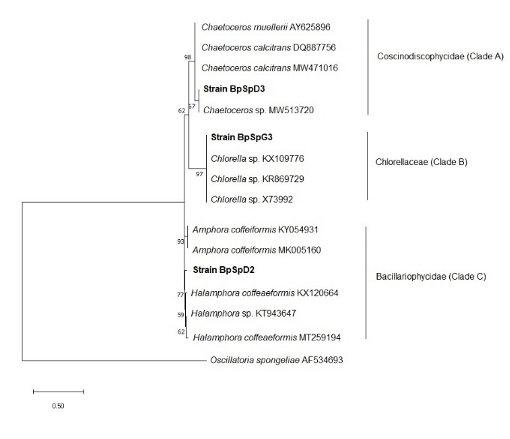

3.2 Ammonia removal by isolated microalgae in culture media added with TAN
The growth performance and ammonia removal ability of the isolated microalgae were tested using a modified F/2 medium added with 2 mg L-1 total ammonia-nitrogen (TAN). Figure 5 illustrates the growth and ammonia removal performance within a 14-day experimental period. Ammonia reduction started on Day 1 and continued until all microalgae entered the mid-exponential and stationary phases, during which the reduction varies by species. Chlorella sp. BpSpG3 exhibited the highest specific growth rate (SGR) at 0.271 ± 0.011, followed by Desertifilum sp. BpSpC1 at 0.236 ± 0.012 and Halamphora sp. BpSpD2 at 0.160 ± 0.008 with no statistically significant differences (p>0.05) between treatments. After 14-days of cultivation, all microalgae species effectively removed 100 % of the ammonia. Halamphora sp. BpSpD2 demonstrated complete ammonia removal within just 5 days of culture, despite having low SGR compared to Chlorella sp. BpSpG3.
3.3 Nitrogen preferences of selected microalgae species, Halamphora sp.
Halamphora sp. BpSpD2 was further selected for nitrogen uptake and growth performance tests in various concentrations of nitrate (NO3--N) and ammonia (TAN). Figure 6 shows the growth performance and nitrogen removal of Halamphora sp. BpSpD2 was cultured in modified F/2 media with 4, 8, 12, 16, 20 and 25 mg L-1 of TAN and nitrate as nitrogen source. A higher biomass and SGR of Halamphora sp. BpSpD2 was found in all ammonia treatments as a nitrogen source compared to nitrate. Furthermore, Halamphora sp. BpSpD2 achieved maximum biomass earlier in ammonia treatments of 12, 16, 20 and 25 mg L-1 TAN compared to nitrate treatment of the same concentration.
The results show that Halamphora sp. BpSpD2 could use both types of ammonia and nitrate in the media. A faster removal rate and removal efficiency were observed for all ammonia treatments compared to the nitrate treatments (Table 2). This was shown through the higher growth of Halamphora sp. BpSpD2 in the ammonia treatment. In this study, Halamphora sp. BpSpD2 was more efficient in removing ammonia than when cultured in nitrate as a nitrogen source. A 100 % removal efficiency of ammonia was achieved in the treatments of 4, 8 and 12 mg L-1 TAN on day 7, 10 and 11, respectively. The treatment of 12 mg L-1 TAN had the highest TAN removal rate of 1.15 mg L-1 d-1, which was nearly two times faster than the treatment of 4 mg L-1 TAN. Meanwhile, in the nitrate treatments, Halamphora sp. BpSpD2 successfully removed 100% of nitrate only in the treatment of 4 mg L-1 and 8 mg L-1 on day 9 and day 12 of the experiment.
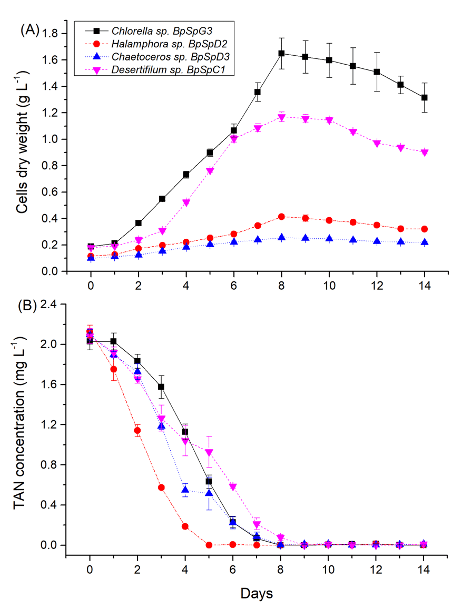
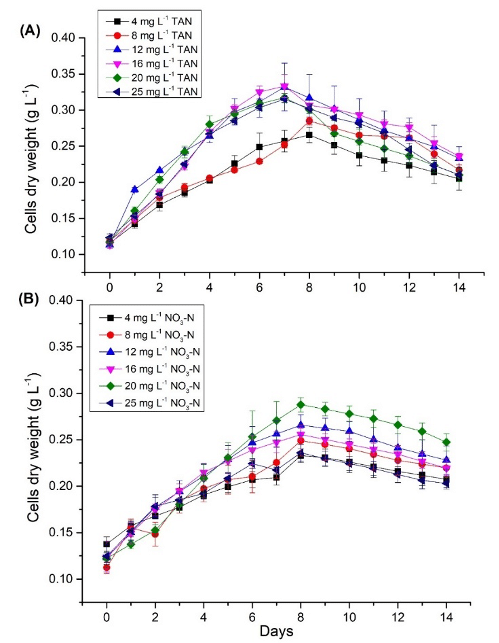
Table 2. Removal of TAN and nitrate at various concentrations by Halamphora sp. BpSpD2.
3.4 Bioremediation of shrimp culture wastewater by Halamphora sp.
Wastewater samples were collected from the early and late stages of Penaeus vannamei shrimp culture ponds. The nitrogen composition of the wastewater is shown in Table 3. Based on the analysis, the late stage of shrimp wastewater has a higher TAN, nitrite and nitrate thus contributing to a higher total nitrogen compared to the early stage of shrimp culture wastewater.
Table 3. Composition of wastewater obtained from shrimp culture ponds.
Figure 7 illustrates the growth performance of Halamphora sp. by measuring the specific growth rate (SGR) throughout a 14-day shrimp wastewater bioremediation treatment. Halamphora sp. experienced lag, exponential, stationary and declining phases in both the initial and final stages of shrimp culture wastewater. The SGR of Halamphora sp. in this study was determined on day 7 in the initial stage condition and on day 6 in the final stage condition. Cultivation of Halamphora sp. in the final stage of shrimp wastewater yielded higher SGR (0.145 day-1) than in the early stage condition with SGR of 0.083 day-1.

Figure 8 depicts the progression of the nitrogen removal during the cultivation of Halamphora sp. in shrimp culture wastewater collected from the early and late stages. In the early stage, the removal rates of TAN, NO2--N, NO3--N and total nitrogen were recorded at 0.11, 0.03, 0.23 and 0.26 mg L-1 day-1, respectively, over an 8-day culture. The total nitrogen concentration in the early-stage sample decreased from 1.64 to 0.32 mg L-1, achieving 80 % removal efficiency. In the late stage, the removal rates of TAN, NO2--N, NO3--N and total nitrogen were measured at 0.46, 0.2, 0.67 and 0.26 mg L-1 day-1, respectively, during a 14-day culture period. The total nitrogen concentration decreased from 26.09 to 10.77 mg L-1, indicating 59 % removal efficiency.
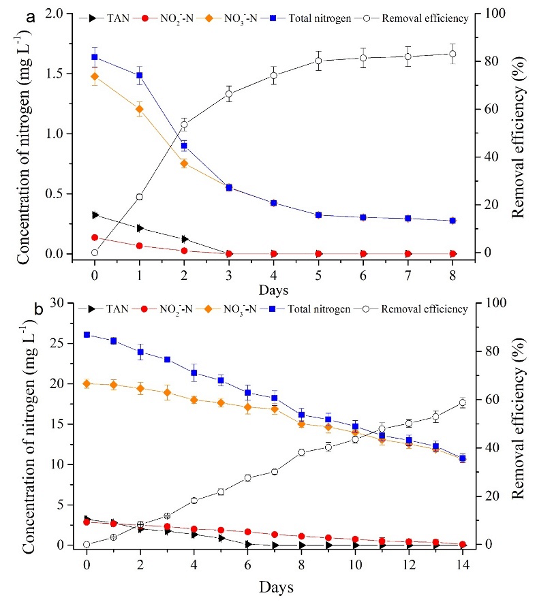
4. Discussion
In this study, two species of diatom, and one species of green algae and cyanobacteria were isolated from shrimp culture pond. Similar results were shared by Shaari et al. (2011) where green algae Chlorella sp., diatom (Amphora sp. and Navicula sp.) and cyanobacteria (Anabaena sp. and Oscillatoria sp.) were isolated from shrimp pond. Microalgae species can be found in abundance in shrimp ponds as they offer an unexhausted source of nutrients as well as optimum conditions needed for their growth. The elevated levels of nitrogen and phosphorus in the shrimp pond stemmed from factors such as heavy input of compounded feed, resulting in feed wastage, the application of inorganic fertilizers, and the excretion of shrimp. The diversity and abundance of microalgae species in shrimp ponds are influenced by physical and chemical factors such as light, temperature, pH, salinity and nutrient availability (Morales et al., 2018).
Microalgae have been utilized for nutrient removal in various settings, including domestic, municipal, livestock, palm oil mill effluent, and aquaculture environments (Pandey et al., 2019; Low et al., 2021; López-Sánchez et al., 2022; Geng et al., 2022). However, only a few researchers isolated and tested indigenous microalgae species for this purpose (Abdelaziz et al., 2014; Lynch et al., 2015). In this study, isolated microalgae Halamphora sp. BpSpD2, Chaetoceros sp. BpSpD3, Chlorella sp. BpSpG3 and Desertifillum BpSpC1 were cultivated in modified F/2 medium added with 2 mg L-1 TAN. Halamphora sp. BpSpD2 was the most efficient in removing ammonia. Diatoms are recognized as promising for wastewater remediation because of their siliceous frustules and metabolic traits, allowing them to utilize nitrate, orthophosphate, silica, and heavy metals (Chaib et al., 2021). The co-cultivation of Amphora sp. (same family as Halamphora sp.) with Navicula sp. and Cymbella sp. grown on a substrate in Penaeus monodon tank significantly lowered the TAN and nitrite concentration in the tanks compared to control treatment (Khatoon et al., 2009; Stepanek and Kociolek, 2013). Moreover, the addition of immobilized Amphora sp. in Penaeus vannamei cultured effluent efficiently removed 86.1% of nitrite and 55.7 % of ammonia (Kumar et al., 2016).
In this study, Chlorella and Desertifillum removed more than 50 % of TAN from the media within 6 days of cultivation. Similarly, Chlorella has been widely used for to treat aquaculture wastewater (Sirakov and Velichkova, 2014). Various Chlorella sp. such as Chlorella sorokiniana, Chlorella ellipsoideaand Chlorella minutissima has been proven to remove nutrients from aquaculture fishery and shrimp wastewater with more than 80% removal of ammonia and phosphate (Mishra et al., 2022). In addition, Desertifilum sp. also has the potential as a bioremediator where it can remove 94 % and 98 % of nitrate and phosphate from dairy wastewater (Khemka and Saraf, 2017). The high growth rate of these microalgae is a key factor contributing to their remarkable nutrient removal potential, as their rapid proliferation enables them to absorb and reduce nutrients in wastewater efficiently.
Halamphora sp., which showed the highest ammonia removal efficiency was further selected to evaluate its nitrogen preferences. In addition, Halamphora sp. BpSpD2 can grow in low and high concentrations of nitrate and ammonia. The specific growth rate measured in this study ranged between 0.10 and 0.20 per day. These values are within the range of published SGR values for benthic marine diatoms (Daglio et al., 2016).
Our study is the first to show the ability of diatom, Halamphora to utilize ammonium and nitrate for growth. A higher biomass and SGR of Halamphora sp. BpSpD2 was found in all ammonia treatments as a nitrogen source compared to nitrate. As growth increased, ammonia was effectively uptake by Halamphora sp. BpSpD2 compared to when cultured in nitrate as a nitrogen source. This occurs because ammonium, being in a reduced state of nitrogen, can be assimilated directly into amino acids within the cellular structure (Podevin et al., 2015). Nitrogen from other sources, like nitrate or nitrite, must undergo reduction to ammonium before it can be used. The growth of Halamphora sp. BpSpD2 was increased with increasing ammonia concentration. This finding is expected as a low level of ammonium is said to be more beneficial than nitrate for their growth even though the amount of nitrogen in the media was the same (Katayama et al., 2020). Similar findings were reported by Tam and Wong (1996) where an increase in ammonia concentration in the culture media from 10 to 20 mg L-1 significantly increased SGR of Chlorella vulgaris. Previous study by Katayama et al. (2020) also reported that diatom Thalassiosira weissflogii grew faster in ammonium-containing media with 1.4 mM NH4+-N than nitrate-containing media. Nevertheless, certain microalgae, like Botryococcus braunii and Dunaliella tertiolecta, prefer nitrate as their inorganic nitrogen source, leading to diminished growth when exposed to ammonium (Ruangsomboon, 2015).
In the final part of this study, the growth of Halamphora sp. BpSpD2 was tested in actual aquaculture wastewater. Growth of Halamphora sp. BpSpD2 was 1.3 times higher than the early-stage treatment. The results indicated that microalgae metabolically absorbed nitrogen and incorporated into their biomass (Guo et al., 2013). Sufficient nitrogen in the late-stage treatments can improve the growth of Halamphora sp.; hence, higher biomass is achieved.
This finding indicates that Halamphora sp. can be used as an effective bioremediator in wastewater with high ammonia concentrations. Industrial and agricultural wastewater, as well as secondary-treated sewage effluent, can provide nitrogen and phosphorus needed for the growth of Halamphora sp. (Babaei et al., 2018). By assimilating ammonium and other nutrients and converting them into microalgal biomass, Halamphora sp. offers an efficient method for nutrient recovery and water purification.
4. Conclusions
Using indigenous microalgae for wastewater treatment offers several benefits due to their inherent physiological traits well-suited for local climate conditions, such as temperature and light intensity. This study showed four Malaysian indigenous species from the shrimp ponds, Halamphora sp. BpSpD2, Chaetoceros sp. BpSpD3, Chlorella sp. BpSpG3 and Desertifilum sp. BpSpC1 were able to remove ammonia after 14 days of cultivation. Halamphora sp. BpSpD2 was the most efficient, removing 100 % ammonia within 5 days. The results also showed that Halamphora sp. BpSpD2 preferred ammonia over nitrate, resulting in higher growth and removal efficiency. Halamphora sp. showed higher growth and 100% ammonia removal efficiency in the late stage of shrimp culture wastewater. In addition, Halamphora sp. can remove 59% to 80% of nitrogen from both early and late stages of shrimp culture wastewater. These findings suggest that Halamphora sp. BpSpD2 has potentially treat the effluent in aquaculture systems containing high ammonia and nitrate concentrations.
Acknowledgements
This study was funded by International Development Research Center (IDRC), Canada and Global AMR Innovation fund (GAMRIF), United Kingdom under the INNOVET-AMR Grant (Project no: 109055).
Data availability statement
Not applicable.
Informed consent statement
Not applicable.
Conflict of interest
The authors declare that they have no conflict of interest.
Author contributions
Conceptualization: Ikhsan Natrah, Nurarina Ghazali, Fatimah Yusoff and Murni Karim; Data collection: Nurarina Ghazali; Nurul Aini and Ninie Diana; Data analysis: Ikhsan Natrah and Nurarina Ghazali; Figure preparation: Nurarina Ghazali. All authors critically reviewed the article and agreed to submit the final version of the article.


